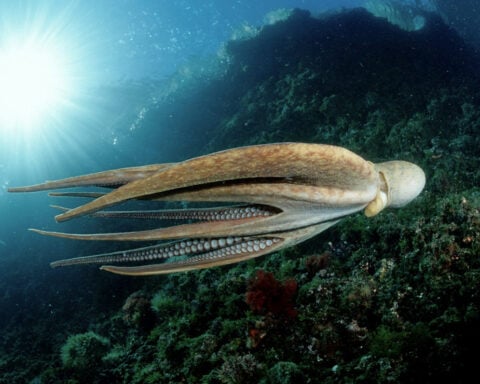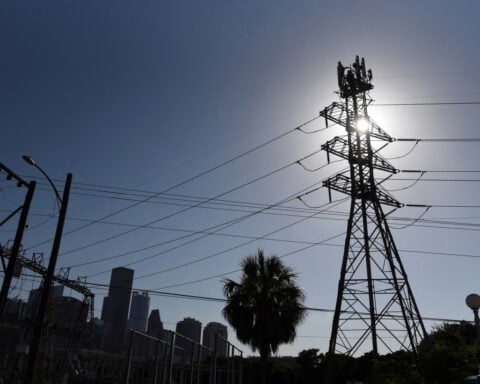By Joey Roulette

(Reuters) -SpaceX in its fifth Starship test flight on Sunday returned the rocket's towering first stage booster back to its Texas launch pad for the first time using giant mechanical arms, achieving another novel engineering feat in the company's push to build a reusable moon and Mars vehicle.
The rocket's first stage "Super Heavy" booster lifted off at 7:25 a.m. CT (1225 GMT) from SpaceX's Boca Chica, Texas launch facilities, sending the Starship second stage rocket toward space before separating at an altitude of roughly 70 km (40 miles) to begin its return to land - the most daring part of the test flight.
The Super Heavy booster re-lit three of its 33 Raptor engines to slow its speedy descent back to SpaceX's launch site, as it targeted the launch pad and tower it had blasted off from. The tower, taller than the Statue of Liberty at over 400 feet, is fitted with two large metal arms at the top.
With its engines roaring, the 233 foot (71 metres)-tall Super Heavy booster fell into the launch tower's enclosing arms, hooking itself in place by tiny, protruding bars under the four forward grid fins it had used to steer itself through the air.
"The tower has caught the rocket!!" CEO Elon Musk wrote on X after the catch attempt. SpaceX engineers watching the company's live stream roared in applause.
The novel catch-landing method marked the latest advance in SpaceX's test-to-failure development campaign for a fully reusable rocket designed to loft more cargo into orbit, ferry humans to the moon for NASA and eventually reach Mars - the ultimate destination envisioned by Musk.
Meanwhile Starship, the rocket system's second stage or top half, cruised at roughly 17,000 miles per hour 89 miles up in space, heading for the Indian Ocean near western Australia to demonstrate about 90 minutes into flight a controlled splashdown.
As Starship reentered Earth's atmosphere horizontally, onboard cameras showed a smooth, pinkish-purple hue of superhot plasma blanketing the ship's Earth-facing side and its two steering flaps, intense hypersonic friction displayed in a glowing aura.
The ship's hot side is coated with 18,000 heat-shielding tiles that were improved since SpaceX's last test in June, when Starship completed its first full test flight to the Indian Ocean but suffered tile damage that made its reentry difficult.
Starship this time appeared more intact upon re-igniting one of its six Raptor engines to position itself upright for the simulated ocean landing.
The SpaceX live stream showed the rocket touching down in the nighttime waters far off Australia's coast, then toppling on its side, concluding its test mission.
A separate camera view from a vessel near the touchdown site then showed the ship exploding into a vast fireball, as SpaceX engineers could be heard on the live stream screaming in celebration. It was unclear whether the explosion was a controlled detonation or the result of a fuel leak.
Musk said the ship landed "precisely on target!"
Starship, first unveiled by Musk in 2017, has exploded several times in various stages of testing on past flights, but successfully completed a full flight in June for the first time.
The U.S. Federal Aviation Administration on Saturday approved SpaceX's launch license for the fifth test, following weeks of tension between the company and its regulator over the pace of launch approvals and fines related to SpaceX's workhorse rocket, the Falcon 9.
(Reporting by Joey Roulette in Milan; Editing by David Evans and Andrea Ricci)

 How to save a fentanyl victim: Key facts about naloxone
How to save a fentanyl victim: Key facts about naloxone
 Eight convicted in France over murder of teacher who showed Prophet caricature
Eight convicted in France over murder of teacher who showed Prophet caricature
 Death toll in German Christmas market car-ramming rises to five, more than 200 injured
Death toll in German Christmas market car-ramming rises to five, more than 200 injured
 Syria's new rulers name foreign minister amid push for international relations
Syria's new rulers name foreign minister amid push for international relations
 Pakistan dismisses US official's warning over missile programme as unfounded
Pakistan dismisses US official's warning over missile programme as unfounded
 Weightlifting Taiwan granny, 90, garners cheers, health benefits at gym
Weightlifting Taiwan granny, 90, garners cheers, health benefits at gym
 Russia's UK embassy denounces G7 loans to Ukraine as 'fraudulent scheme'
Russia's UK embassy denounces G7 loans to Ukraine as 'fraudulent scheme'
 Retailer Party City files for bankruptcy, will wind down 700 stores
Retailer Party City files for bankruptcy, will wind down 700 stores
 Philadelphia 76ers star Joel Embiid working through injuries and mental health struggles
Philadelphia 76ers star Joel Embiid working through injuries and mental health struggles
 Soccer's top players have had enough, as FIFA's new super-sized tournament sparks a revolt
Soccer's top players have had enough, as FIFA's new super-sized tournament sparks a revolt







